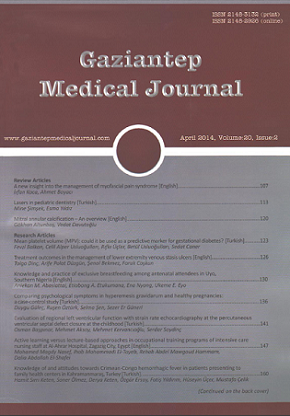Knowledge of and attitudes towards Crimean-Congo hemorrhagic fever in patients presenting to family health centers in Kahramanmaraş, Turkey
Kahramanmaraş’ta aile sağlığı merkezlerine başvuran hastaların Kırım Kongo kanamalı ateşi konusunda bilgi ve tutumları
DOI:
https://doi.org/10.5455/GMJ-30-153375Keywords:
Attitudes, Crimean-Congo, KnowledgeAbstract
The aim of this study was to reveal knowledge of and attitudes towards Crimean-Congo hemorrhagic fever in patients presenting to family health centers in Kahramanmaraş, Turkey. The study was carried out on 98 patients presenting to five family health centers in Kahramanmaraş, Turkey, in February 2014. The patients were informed about the study and those giving written informed consent were included in the study. The mean age of the patients was 36.01±13.43 years (18-68). Out of 98 patients included in the study, 41 (41.8%) were males and 57 (58.2%) were females. None of the patients were offered education about Crimean-Congo hemorrhagic Fever. Eighteen patients (18.4%) noted that they had sufficient information about the disease, but 80 patients (80.6%) noted that they did not have sufficient information. Forty-three patients (43.9%) wanted to receive education about the disease, but 55 (56.1%) did not want to get education. Thirty-six males (87.8%) and 43 females (75.4%) noted that they heard about the disease before. Twelve points three percent of the females and 2.4% of the males found it right to kill ticks by pressing a cigarette lit on it or by lighting it. Thirtyfour females (82.9%) and 44 males (77.2%) reported that Crimean-Congo hemorrhagic fever could be transmitted by tick bites. The results of the study revealed that the patients presenting to family health centers did not have sufficient information and did not have desired attitudes towards Crimean-Congo hemorrhagic fever.
Metrics
References
Williams RJ, Al-Busaidy S, Mehta FR, Maupin GO, Wagoner KD, Al-Awaidy S, et al. Crimean-Congo haemorrhagic fever: a seroepidemiological and tick survey in the Sultanate of Oman. Trop Med Int Health 2000;5(2):99-106.
Ergonul O. Crimean-Congo haemorrhagic fever. Lancet Infect Dis 2006;6(4):203-14.
Ergonul O, Celikbas A, Dokuzoguz B, Eren S, Baykam N, Esener H. Characteristics of patients with Crimean-Congo hemorrhagic fever in a recent outbreak in Turkey and impact of oral ribavirin therapy. Clin Infect Dis 2004;39(2):284-7.
Karti SS, Odabasi Z, Korten V, Yilmaz M, Sonmez M, Caylan R, et al. Crimean-Congo hemorrhagic fever in Turkey. Emerg Infect Dis 2004;10(8):1379-84.
Bakir M, Ugurlu M, Dokuzoguz B, Bodur H, Tasyaran MA, Vahaboglu H. Crimean-Congo haemorrhagic fever outbreak in Middle Anatolia: a multicentre study of clinical features and outcome measures. J Med Microbiol 2005;54(Pt 4):385-9.
İnceboz T, Över L, Şimşek H. Sağlık çalışanlarının kene ve kene vektörlüğüne ilişkin bilgi düzeyleri. 16. Ulusal Parazitoloji Kongresi Program ve Özet Kitabı, s. 301-302, 1- 7 Kasım 2009.
Hoogstraal H. The epidemiology of tick-borne Crimean- Congo hemorrhagic fever in Asia, Europe, and Africa. J Med Entomol 1979;15(4):307-417.
Whitehouse CA. Crimean-Congo hemorrhagic fever. Antiviral Res 2004;64(3):145-60.
Vançelik S, Avşar Ü, Aktürk Z. Erzurum ili kırsalında halkın Kırım Kongo kanamalı ateşi hakkında bilgi, tutum ve davranışları. Turkiye Parazitol Derg 2012;36(3):156-9.
Turfaner Ertürk N, Süt N, Sipahioğlu F. A three years profile of patients referring to family medicine outpatient clinics. Cerrahpaşa J Med 2004;35(3):115-21.
Buğdaycı R, Şaşmaz. T, Kurt AÖ, Tezcan H. Bir kent tipi sağlık ocağında yazılan tanıların incelenmesi. Hacettepe Toplum Hekimliği Bülteni 2002; Sayı 4. http://www.thb.hacettepe.edu.tr/arsiv/2002/sayi_4/basli k1.pdf Accessed on 07 March 2014.
Mash B, Fairall L, Adejayan O, Ikpefan O, Kumari J, Mathee S, et al. A morbidity survey of South African primary care. PLoS One 2012;7(3):e32358.
Fleming DM, Cross KW, Barley MA. Recent changes in the prevalence of diseases presenting for health care. Br J Gen Pract 2005;55(517):589-95.
Öztürk A, Horoz D, Borlu A, Balcı E, Gün İ. Sağlık ocağına başvuran erişkinlerin Kırım Kongo kanamalı ateşi konusunda bilgi ve tutumları. Erciyes Tıp Dergisi 2011;33(2):121-8.
Yilmaz R, Ozcetin M, Erkorkmaz U, Ozer S, Ekici F. Public knowledge and attitude toward Crimean Congo hemorrhagic fever in Tokat Turkey. Iran J Arthropod Borne Dis 2009;3(2):12-7.
Ozer A, Miraloglu M, Ekerbicer HC, Cevik F, Aloglu N. Knowledge levels about Crimean-Congo hemorrhagic fever among midwifery and nursing students in Kahramanmaras, Turkey. Southeast Asian J Trop Med Public Health 2010;41(1):77-84.
Akyazı R, Ecevit O. Keneler ve Kırım Kongo kanamalı ateşi. Ondokuz Mayıs Üniversitesi Ziraat Fakültesi Dergisi 2006;21(3):340-9.
Downloads
Published
How to Cite
Issue
Section
License
Copyright (c) 2023 European Journal of Therapeutics

This work is licensed under a Creative Commons Attribution-NonCommercial 4.0 International License.
The content of this journal is licensed under a Creative Commons Attribution-NonCommercial 4.0 International License.


















